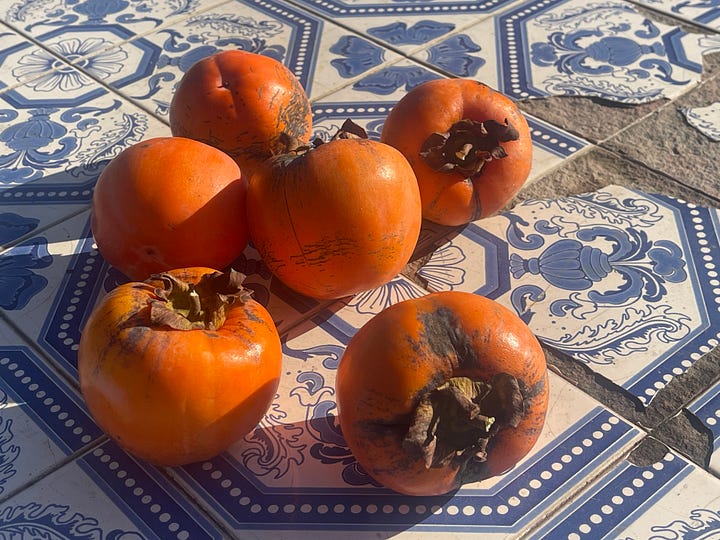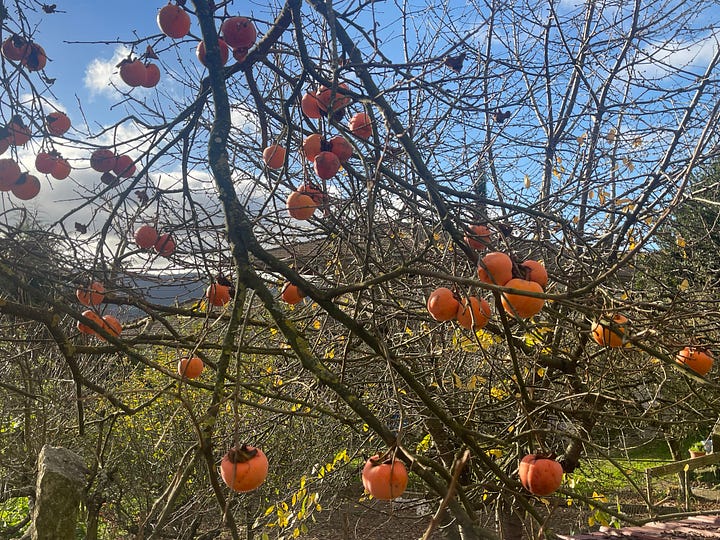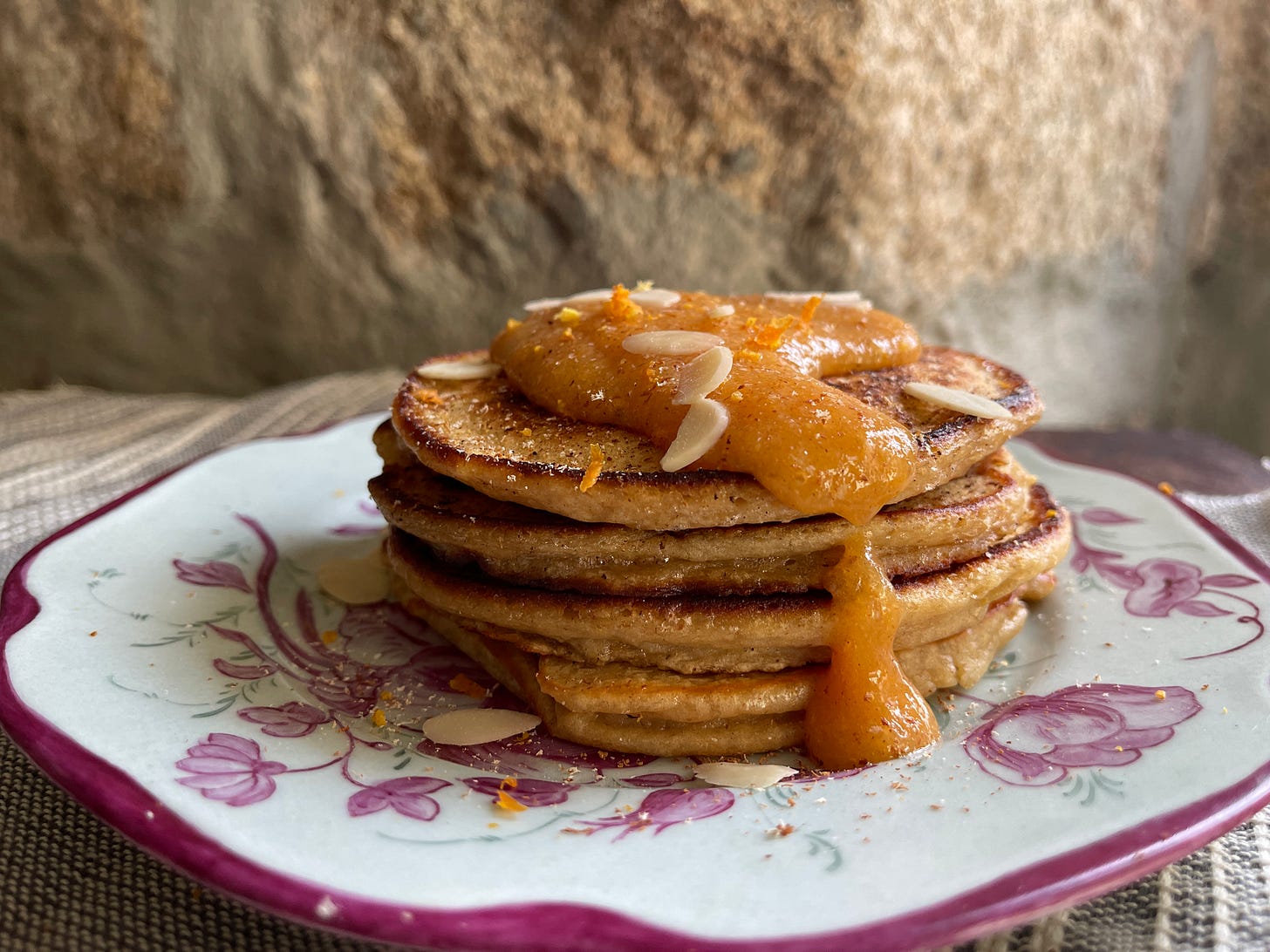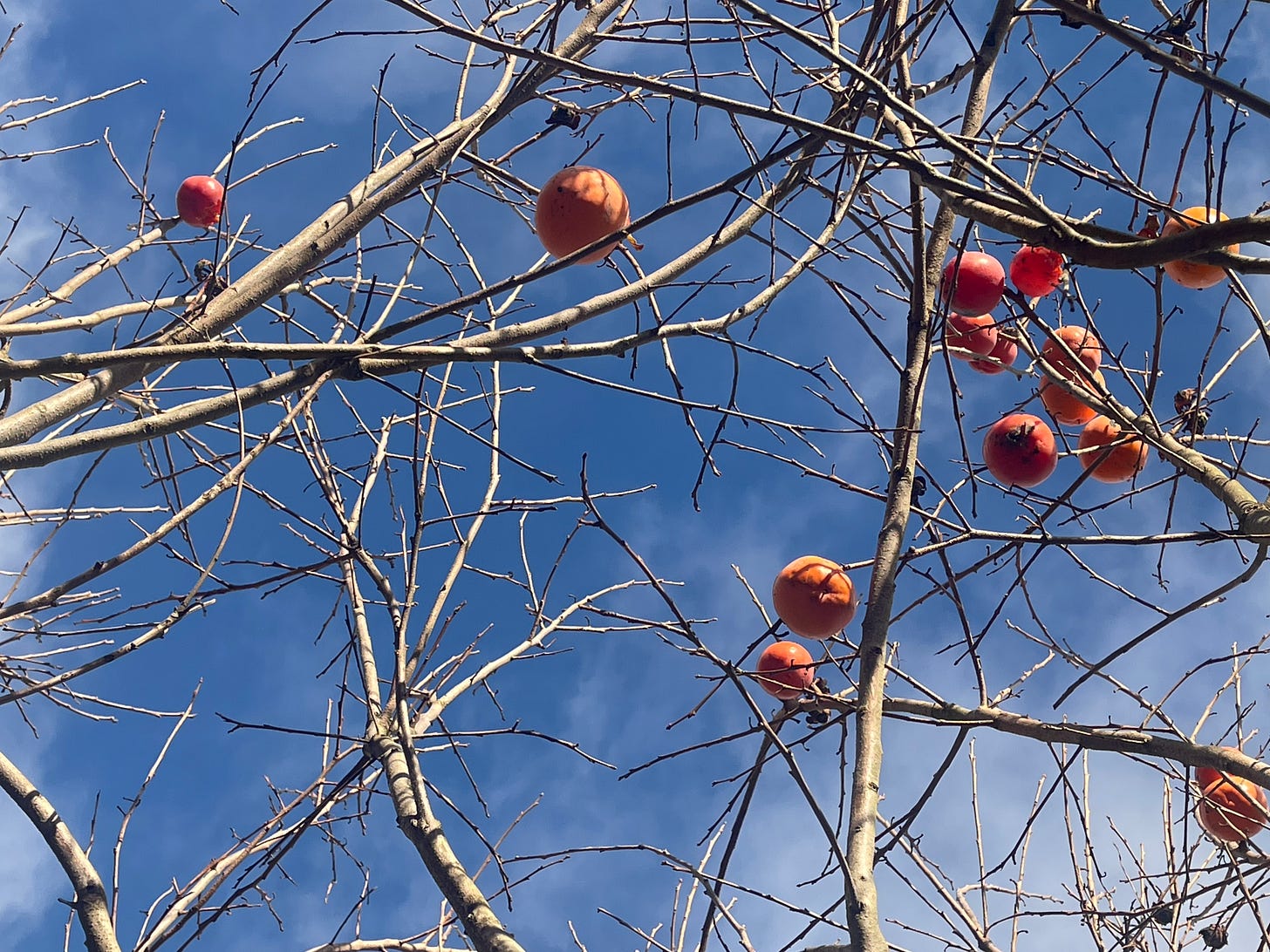From Chaos to Calm: How Hygge Can Ground Us in Tumultuous Times
with a recipe for persimmon pancakes & a guide for simple ways to make 2025 your year of hygge
Welcome to What’s Good Here, a weekly newsletter of recipes, guides, inspiration and expat news. Thank you for being here! This post is free, so please feel free to share it with the food and travel lovers in your life. What’s Good Here is a reader-supported endeavor. To support this publication and to gain access to all recipes, guides, giveaways and other perks, please consider becoming a subscriber. Thank you!
In a world where it feels like the axis of reality is shifting, where facts are contested and madness becomes normalized, it’s no wonder so many of us feel unmoored. There’s a creeping sense of instability—a collective anxiety that gnaws at the edges of our lives as headlines remind us that we’re living in tumultuous times. For some, it’s the threat of political upheaval. For others, it’s climate change, social divisions, or the erosion of trust in institutions that once felt solid. Whatever the source, the result is the same: a pervasive uncertainty that makes it hard to breathe, let alone feel grounded.
I’ve felt this, too. The sheer weight of what’s happening—the way we’re forced to adapt to a world where facts seem irrelevant and chaos is normalized—can feel overwhelming. But in this swirling storm one of the things I turn to I first learned about in a book I co-wrote called The Hygge Life and now in workshops I teach to organizations around the world about how to incorporate the lessons of hygge into our home and work lives.
Hygge, the Danish concept of comfort and coziness, often gets dismissed as a trend or reduced to aesthetics—candles, blankets, wool socks, hot cocoa. But the heart of hygge isn’t about Instagrammable moments; it’s about deliberate acts of care—for ourselves, for others, for our environment. And in times like these, it’s not woo-woo self-help. It’s survival.
Through my workshops, I’ve explored how practical lessons from hygge can help us stay grounded when the world feels unsteady. Hygge isn’t a solution to the chaos. It doesn’t stop political turmoil or mend fractured societies. But what it offers is a way to anchor ourselves, to create small pockets of stability and connection that help us navigate the storm in our everyday lives. It makes me feel more resilient. I love the conversations we have at the end of my presentation about how participants are planning to incorporate small acts into their lives to feel more connected, more grounded, more prepared for the onslaught of news we encounter everyday.
When the world feels out of control, routines become lifelines. Hygge teaches us to embrace rituals—not as rigid schedules but as anchors that bring us back to the present. Whether it’s brewing tea every morning with intention, lighting a candle at the end of the day, bringing a bowl of soup to an elderly neighbor who might feel isolated, or dedicating a quiet moment to journaling or committing to reading 10 pages a day, these practices remind us that we can still create order, even in chaos. They are small, deliberate acts of resistance against the feeling that everything is falling apart.
One of hygge’s core tenets is togetherness. It encourages us to nurture our relationships, to invest in real, meaningful connections. In a time when division and isolation are rampant, gathering with others—even virtually—is more than just comforting; it’s necessary. Whether it’s sharing a meal with family, hosting a low-pressure gathering with friends (seriously, nobody cares if there’s dust on your bookshelf, they’re just happy to be there), or simply calling someone to check in, these moments remind us that we are not alone. Connection is a counterweight to despair.
Nature plays a quiet but profound role in hygge. It doesn’t ask for anything; it just offers its presence. A walk in the woods, sitting by a stream, or even tending to a windowsill garden can ground us in ways nothing else can. When the world’s chaos feels too big, the rhythms of nature remind us of something larger, something enduring. The wind doesn’t care about politics. The trees will keep growing. The seasons ensure the cycles of life endure. Hygge reminds us to pay attention to these small truths.


Recently, I’ve started collecting persimmons from the trees in northern Portugal. As winter deepens, these nearly overripe fruits, with branches drooping from their weight, feel like a gift—something vibrant and sweet in the midst of the cold. Hygge is about noticing these gifts and turning them into something that brings warmth and joy. When I mash the persimmons and fold them into batter to make persimmon pancakes, I’m reminded of the small but meaningful ways we can find light in the dark. The act of transforming what the season offers into a cozy, nourishing meal is the essence of hygge—a deliberate choice to find comfort and beauty in the everyday.
Hygge also asks us to notice the small things—a warm mug in your hands, the sound of rain, the softness of a well-worn sweater, the poet, musician or painter who inspires us—and find solace in them. These moments don’t erase the pain or fear of the world, but they offer a counterbalance. They are reminders that, even in darkness, there is light.


To bring hygge into your own life, start small. Dedicate a nook in your home to calm, with soft lighting, books, and a blanket. Simplify your gatherings by focusing on connection rather than perfection. Adopt small rituals like lighting a candle or brewing tea at the same time each day. Engage your senses with natural scents and soothing textures. And be intentional with technology—curate your online spaces to bring inspiration rather than anxiety.
These are not solutions to the world’s problems. They won’t stop climate change or fix political divisions. But they offer a way to keep moving forward, to stay grounded and sane when the world feels unrecognizable. Hygge is a reminder that, even when we can’t control the world, we can still control how we move through it. It’s about finding strength in small moments, in deliberate actions, in the connections we foster.
As we face the uncertainty ahead, let’s not dismiss these acts as trivial. They are, in their own way, acts of resilience. They remind us that we are human, that we can still create pockets of light and warmth for ourselves and for others even when the world feels cold and dark. And maybe, just maybe, those small acts will be enough to carry us through.
News & Favorites
Elysian Kitchens: Published on October 15th by W.W. Norton, it’s available online as well as in many independent bookstores. It’s appeared on The Splendid Table, Saveur and many other places. If you’ve picked up a copy and enjoyed it, I’d be so grateful if you’d consider leaving a review—they truly help. There will be more news and behind-the-scenes stories about Elysian Kitchens in the coming months, along with an event series inspired by the book that kicks off in Minnesota in spring 2025, Ireland in July, and Italy and Portugal in October. More info will be available at the end of January.
Eat Like a Monk: A Plant-Based Guide to Conscious Cooking and Mindful Eating: I had a book last year by Simon & Schuster comprised of plant-based recipes primarily inspired by Buddhist monasteries throughout Asia. More on Eat Like a Monk soon, including some of my favorite recipes from the book (they’re really bright and vibrant)!
London Writers Salon: On January 14th I’ll be joining a conversation with the London Writers' Salon, a vibrant community dedicated to helping writers succeed through daily writing sessions, expert interviews, and masterclasses.In this session, I'll share insights from my experiences and discuss the journey of writing and publishing my latest cookbook, Elysian Kitchens along with a deep dive into how to navigate a career in the culinary world.You can register here and use code LWSFRIEND15 for a 15% discount!
Forks Over Knives: I’m a frequent contributor to Forks Over Knives and in the print issue for Winter 2025, I developed recipes inspired by iconic diner favorites with a plant-based twist. It’s available now and includes nearly 85 vibrant, plant-based recipes just in time for winter!
The Life Impossible by Matt Haig: In 2024, I set myself the goal of reading 70 books—and I exceeded it, finishing 74! Heading into 2025, I’m determined to keep that momentum, and I couldn’t have chosen a better book to kick off the year than Matt Haig’s The Life Impossible. With its poignant and uplifting exploration of resilience and what it means to live fully, this book feels like the perfect way to set the tone for another year of growth, discovery, and, of course, great reads.
The art of being happy lies in the power of extracting happiness from common things.
- Henry Ward Beecher
My newsletter is reader-supported.
Free subscribers get limited access to the weekly newsletter and two weeks worth of archives.
Paid subscribers get complete access to all of the content in my newsletters and my entire archives. You’ll also get all of the recipes, guides, interviews, cooking tips, essays and more, plus the ability to comment and participate in discussions.
If you’d like this week’s recipe along with my hygge guide, consider upgrading to paid. Thanks!
In 2025, I will be offering my standard hygge workshops along with new workshops on cookbook writing, becoming an expat and more. Paid subscribers will receive a 50% discount on their first course. More info coming in the next newsletter.
Newsletters will arrive right in your Inbox or you can read them through the app.





